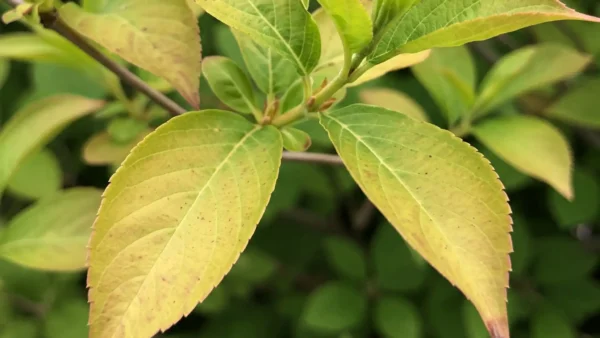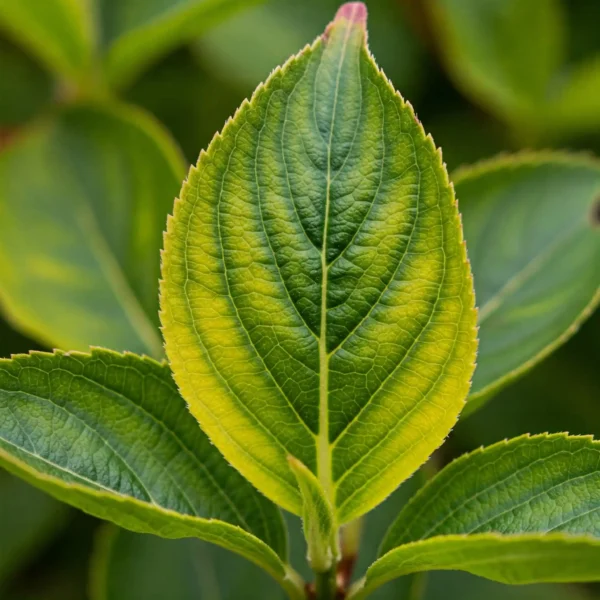Spider Mites Attacking Your Weigela? Identify and Eliminate
Is it not a sad sight? On your Weigela all year, you have been yearning for those exquisite, trumpet-shaped flowers; instead, you are seeing yellow leaves, a depressed, drooping appearance, and perhaps some unusual, silky threads. You are doing everything perfectly, so what is wrong? This is a difficult fact whereby occasionally our finest gardening plans—such as putting a plant in a hot, bright area for maximum bloom—may unintentionally provide the ideal storm for some pests.
Take a long inhale, then. If this sounds familiar, I can tell you almost definitely what the issue is and, more importantly, how to fix it. Indeed, classic indicators of spider mites invading your Weigela are the fine webs and stippled, yellowing leaves of your cherished plant. The two-spotted spider mite (Tetranychus urticae) is the most often occurring offender; it is an equal-opportunity destroyer and loves the hot, dry, dusty surroundings that can strain a Weigela.
The good news is, though, you have arrived at the correct location. These bugs are totally beatable even if their very fast life cycle makes them formidable. Consider this your whole war plan, including from advanced control and future-proofing to deep diagnostics. So let’s go right to restoring your lovely Weigela to its natural beauty.
Deciphering the Damage: Ensuring You Deal with Spider Mites on Your Weigela
First of all, we have to be absolutely certain we are facing the correct foe. Although fungal illnesses or nutrient deficits can be confused with spider mite damage, there are a few clear indicators that set them apart. If you have a magnifying glass, get it; it will be your friend most certainly.
Exactly what to search for is here:
- An “Stippled” view. Study the top surface of the leaves closely. Do you observe a fine pattern of white or yellow little dots? Stippling is the name given here. Every one of those tiny spots serves as a feeding ground for mites whose stylet-like mouthparts puncture individual plant cells and draw out the chlorophyll. Stippling looks more like the color has been softly airbrushed away in tiny pinpricks than fungal patches, which sometimes have a distinct border or fuzzy texture.
- Yellowing and “Bronzing” leaves. Those minute dots will combine as the mite colony expands. Processed as “bronzing,” the leaves lose their rich green hue and become a sickly yellow or coppery-bronze tone. Unable to photosynthesize efficiently, they grow brittle and may finally fall off the plant completely.
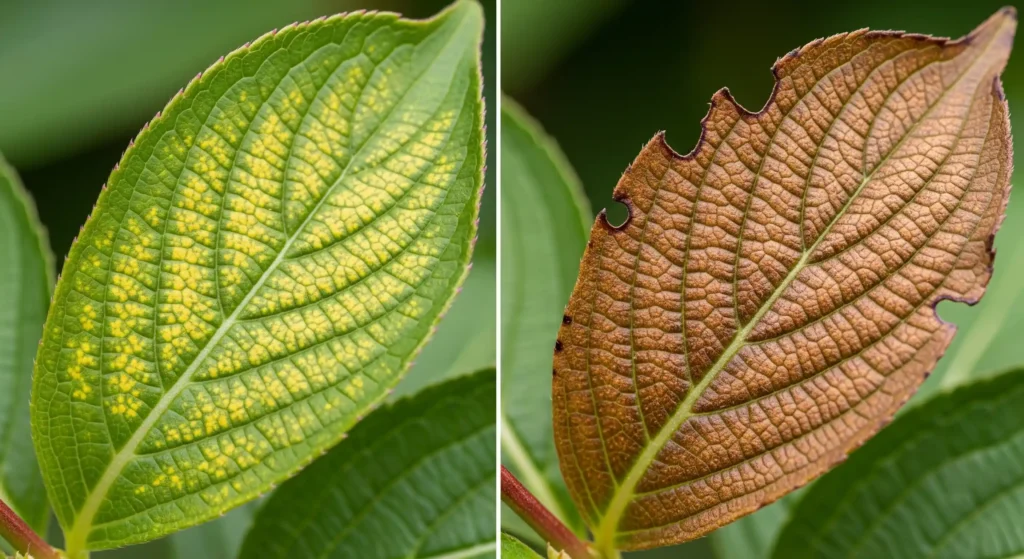
- Sensual, delicate webbing. This is the smoking gun, evidence of a firmly entrenched colony. To defend themselves and their offspring from predators and provide a microclimate with more humidity, spider mites build quite fine, complex webbing. Usually found on the underside of the leaves and in the curves where they join the stems, it is. This webbing is far more fragile and dense than the larger, more obvious webs of a common garden spider, so avoid confusing this with them.
- A miserable plant. Your Weigela will just seem worn-out overall. Its energy reserves are being methodically reduced, so it will lack vitality, seem drooping, and have stunted growth.
Not sure yet? The White Paper Test
Allow me to introduce a venerable tactic from my own garden battles: the white paper test. It provides a definite response, is straightforward and efficient. You do as follows: Under a branch you believe to be infested, hold a fresh piece of white paper under it and give it a few firm taps. Look at the paper right now. Look at those minute dots like pepper or dust. Wait another moment. You have located your offenders if they start to crawl about. Wipe your finger lightly over the specks to get last assurance. You have identified spider mites officially if they leave behind reddish-brown or greenish-brown streaks.
Your Complete Guide to Eliminating Spider Mites: The Counter-Attack, Step-by-Step
Alright, you’ve verified the invasion. Calm yourself not panics! Control of spider mites depends mostly on tenacity and a multi-pronged strategy. Their life cycle is so quick—an egg can become a reproducing adult in as little as five days in hot weather—that one treatment is usually insufficient. We are going from defense to attack.
The Natural Route: Mild yet Effective Remedies
- First do a Power Wash. A forceful stream of water physically disturbs the dry, low-humidity environment mites, eggs, and webs prefer and physically removes many of them. Sometimes doing this every other day for a week will be sufficient to stop the population increase in a modest infestation.
- Work with oil or horticultural soap. Should water be insufficient, you will next turn to a contact spray. Made from potassium salts of fatty acids, insecticidal soaps transcend simple dish soap in water. It acts on contact by dissolving the delicate outer cuticle of the mite, therefore inducing dehydration and death. Highly refined mineral oils (or plant-based oils like cottonseed) block their spiracles, or breathing tubes, therefore drowning mites and their eggs. Though they burn leaves, they are rather efficient and should be used sparingly in hot weather. Spray always in the cooler evening hours.
- Release the potential of Neem Oil. Actually, cold-pressed neem oil is the one hero in the toolset of the organic gardener. Azadirachtin is the chemical source of its power. Azadirachtin is a great multi-tool unlike pure contact killers in soaps and oils. It is an antifeedant, a repellant, and a growth inhibitor. Better still, it’s “translaminar,” which means it gets into the leaf tissue. Later on when they try to feed on the treated leaf, mites that aren’t killed on touch will be impacted.
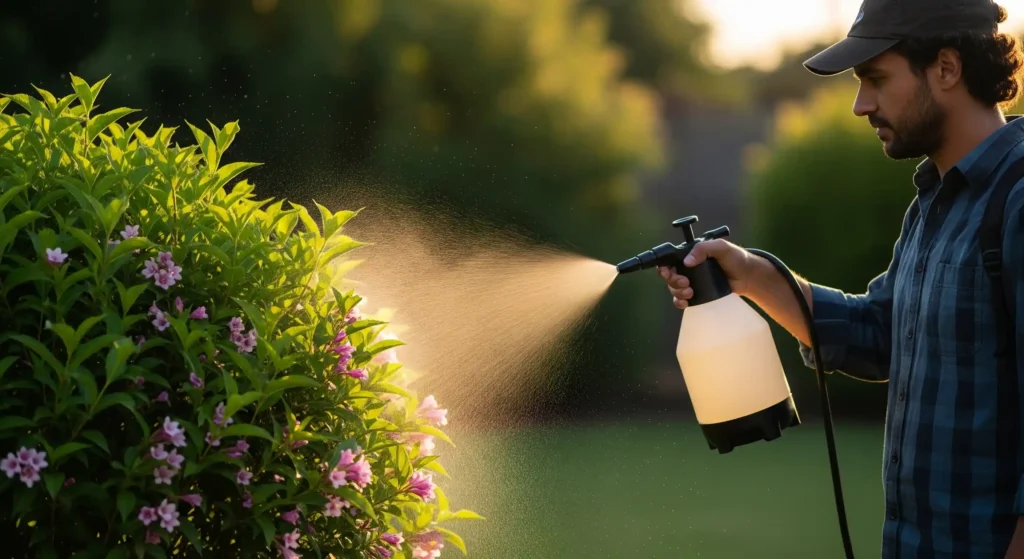
Advanced Biological Controls: Choosing a Micro-Assassin
Release helpful predatory insects if you want a really sustainable, long-term fix.
- The standout performer is Phytoseiulus persimilis. a predatory mite designed just for hunting spider mites. Distributing these onto a contaminated factory can feel like releasing a small special operations squad. They can rapidly destroy a colony and proliferate twice as fast as spider mites.
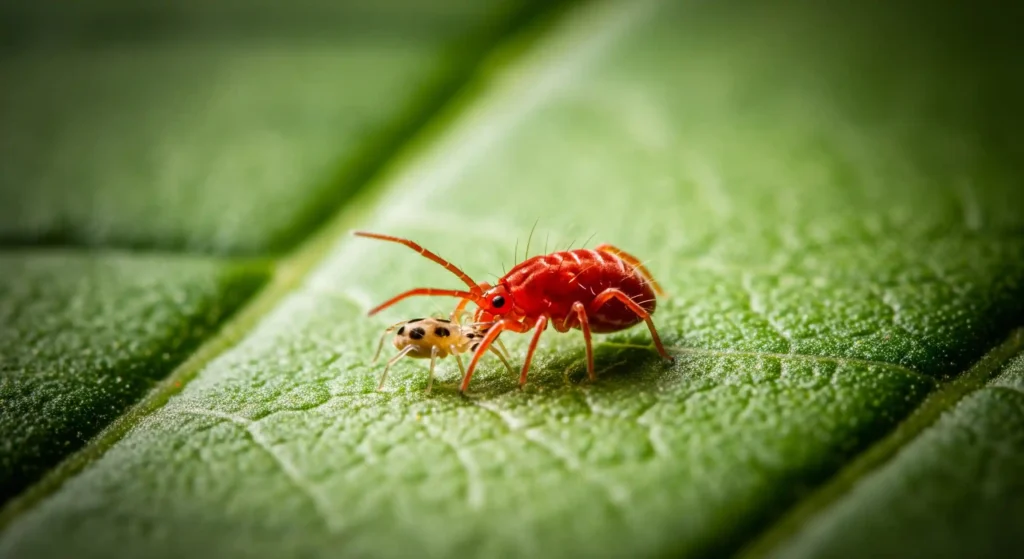
- Another predatory mite an excellent choice if the mite population isn’t yet out of hand is Neoseiulus californicus. Though they are not as ravenous as P. persimilis, they are great for early in the season preventative releases since they can survive longer on other food sources (such as pollen).
Regarding severe infestations: when should one give thought to chemical miticides?
I consider this to be a last resort always. Sometimes, though, an infestation is so advanced that compromises the plant’s survival. Should you choose this path, you have to be strategic.
- Use a Labeled “miticide”: Since mites are arachnids rather than insects, a generic insecticide might not be very effective.
- Rotate Chemical Classes: Mites are well known for becoming resistant. You have to rotate among several chemical classes (shown on the product label by a “Group Number”). For one spray, you might use a Group 6 miticide—such as abamectin—then change to a Group 21 miticide—such as tebufenpyr. This stops immunity from building among the mite population.
- Avoid Mite Flare-Ups: Certain broad-spectrum pesticides, particularly carbamates and pyrethroids, can actually aggravate a spider mite problem. Their elimination of the natural enemies of the mites causes a population surge sometimes referred to as a “mite flare-up.”
Strengthening Your Weigela: Strategies to Stop an Invasion in Future Years
You want to win the war once you have emerged from the fight. Stressed plants attract pests, hence our aim is to use an Integrated Pest Management (IPM) approach to make your Weigela a target of least attraction.
Your advanced checklist for a fortress-strong Weigela follows:
- Water Deeply and Wisely. Deeply and completely water your Weigela at the base; let the soil dry somewhat between waterings. This guarantees hydration of the roots, therefore strengthening the whole plant.
- Plant fertilizers. Inaccuously Steer clear of too generous nitrogen fertilization. For sap-sucking parasites like spider mites, soft, luxuriant new growth produced by high-nitrogen fertilizers is quite enticing. Use a slow-release, balanced fertilizer designed for shrubs in bloom.
- Boost Natural Predators. Create a varied yard. Nearby plants such dill, cilantro, cosmos, and yarrow can draw helpful insects including lacewings, ladybugs, and minute pirate bugs—all of which feed on spider mites.
- Sort New Plants in Quarantine. Hitchhiking on fresh plants is one of the most often used methods by pests into a garden. For at least two to four weeks, keep new plants apart from the rest of your garden.
- Remain vigilant with magnificence. Get a loupe from 10x or 15x jewelers. This little instrument will help you garden differently. With it, long before you ever see webbing, you can find the small, translucent mite eggs on the underside of leaves.
- Perform a meticulous fall clean-up. In garden trash, dirt, and bark, mated female spider mites overwinter in a state called diapause—a kind of hibernation. By completely cleaning fallen leaves and weeds, their winter cover is eliminated and spring mite count is much lowered.
Finally: Taking Back Your Beautiful Weigela
Seeing a beloved plant suffer might be quite depressing, but right now you are completely armed with a thorough awareness of your enemy. You are aware of their behaviors, life cycle, and shortcomings. From the first concern over yellow leaves, you have developed into a proactive protector for your garden, a skilled warrior, and a pest investigator. Your passport to long-term success is vigilance, tenacity, and comprehensive pest control taken together.
Following these guidelines will help you defeat spider mites invading your Weigela and return to what counts most: savoring its breathtaking, vivid blossoms season after season.
Commonly Asked Questions
Why do spider mites tend to return annually to the same plant?
Usually this is the result of overwintering. Fall brings a hibernation-like state for mating female mites, who hide in bark fissures, leaf litter, or even the ground near the base of the plant. Rising spring temperatures cause emergence, crawling up the plant, and beginning of the cycle all over again as they lay eggs. Your best line of protection against its comeback is a thorough fall cleanup.
Are some Weigela cultivars more spider mite resistant?
Although particular mite-resistant Weigela cultivars are not well-documented, resistance is nearly invariably associated with general plant vigor. Naturally more resilient and less appealing to pests are cultivars kept healthy by good care that fit your particular climate and soil conditions. One of the most important preventative actions is selecting a strong variety and keeping it happy.
Will spider mites truly destroy my Weigela?
Although a minor infestation is unlikely to be lethal, a severe, treated infestation definitely can kill a Weigela. The continuous feeding stresses the plant greatly, deplete its resources, and increases its susceptibility to various illnesses. Early intervention is therefore really vital.
With the unaided eye, are spider mites visible?
Really challenging! Usually unseen until their population explodes, they are quite little. Long before you can see the mites themselves, you are far more likely to find their damage—the stippled leaves and tiny webbing. For a positive ID, this is the reason the white paper test and a good magnifying loupe are so priceless.





